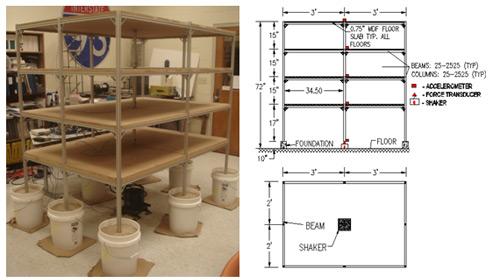Prediction and mitigation of the Train induced floor vibration in Buildings
With the rapid urbanisation of the cities, buildings are being subjected to potentially disturbing vibrations and noise due to nearby trains. Laboratories and manufacturing facilities located in these areas have serious concern about the improper functioning of sensitive laboratory devices and precision manufacturing equipment.
This research is based on the prediction of the behaviour of building floor vibration using mathematical model and its validation through the experimentally measured data. A scale model building (as shown) has been prepared by graduate student, Ningyu Zhao, in the structural engineering laboratory at Tufts University. The structure when subjected to shaker induced vibration generates vibration. The measurement of these vibrations at each floor level is done by means of accelerometers and the load applied is measured through load cell. An impedance based model with infinite Kirchhoff and Mindlin plates are used for prediction of floor vibrations. Predicted vibrations are then compared with measured values for validation.
A number of full-scale building floor vibration tests and impedance modelling have been conducted for Boston Convention Center, TD Banknorth Garden, MIT Brain and Cognitive Science Center, 675 Massachusetts Avenue, and Anderson Hall at Tufts University, under the guidance of Prof. Sanayei and in close collaboration with Acentech, Inc. and LeMessurier Consultants in Cambridge, MA.
